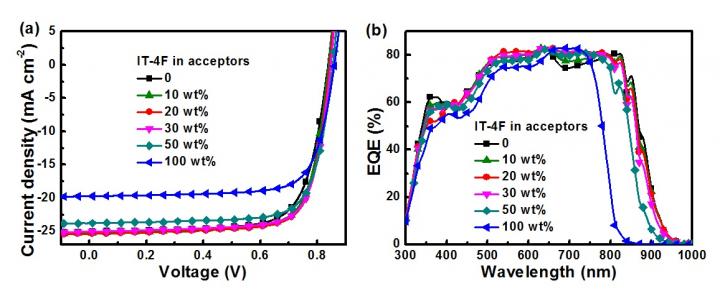
Credit: ©Science China Press
It has become a hot topic to further improve the efficiency of polymer solar cells (PSCs) from device physics. Ternary strategy provides a very potential solution for simultaneous optimization of materials selection and device fabrication process. Since 2013, Prof. Fujun Zhang’s group focused on the research of ternary PSCs. Zhang’s group has carried out a series of researches on ternary system, such as polymer/small molecule, polymer/polymer, small molecule/small molecule, double donor, double acceptor, etc. The preparation technology of “two-step method” and “inverted method” were reported successively, and some new methods were designed for studying the exciton and carrier dynamics in ternary PSCs. The compatibility of materials is a key factor to affect the phase separation of active layer, intermolecular interactions, device performance and working mechanism. The working mechanisms of ternary PSCs are still under investigation. For example, the “alloy model” may be a macroscopic phenomenon caused by the degeneracy of the excited state energy level between materials, and its microscopic nature is not changed.
Recently, ternary PSCs with 16.27% efficiency were reported by Fujun Zhang’s group, which has been published on the Science Bulletin in the form of Short Communication.
PM6:Y6 and PM6:IT-4F two binary PSCs exhibit complementary short circuit current density (Jsc, 25.08 mA cm-2 vs. 19.75 mA cm-2), open circuit voltage (Voc, 0.836 V vs. 0.860 V) and fill factor (FF, 73.2% vs. 75.1%). The three photovoltaic parameters of PM6:Y6:T-4F ternary PSCs can be optimized by adjusting the content of IT-4F in acceptors. When the content of IT-4F is 20 wt%, the ternary PSCs achieve optimized efficiency of 16.27% with a Jsc of 25.40 mA cm-2, a Voc of 0.844 V and a FF of 75.9%. In this work, the up-side-down solvent vapor treatment was employed to optimize the phase separation of active layers, which was firstly proposed by Zhang’s group.
Simple preparation process and high repeatability are the inevitable requirements for the industrialization of PSCs. The ternary PSCs without solvent additive show great potential in the industrialization of organic photovoltaic. In addition to enhancing the photon harvesting of active layer, the third component can also optimize photogenerated excitons bulk distribution to improve the performance of PSCs. This work further proves that the ternary strategy have the potential to become the first choice for the industrialization of PSCs.
###
This work was supported by the Fundamental Research Funds for the Central Universities (2018JBM061), National Natural Science Foundation of China (61805009, 61675017). Beijing Natural Science Foundation (4192049).
Qiaoshi An, Xiaoling Ma, Jinhua Gao, Fujun Zhang. Solvent additive-free ternary polymer solar cells with 16.27% efficiency. Science Bulletin, 2019, 64(8)504-506, doi: 10.1016/j.scib.2019.03.024
https:/
Media Contact
Fujun Zhang
[email protected]
Related Journal Article
http://dx.




